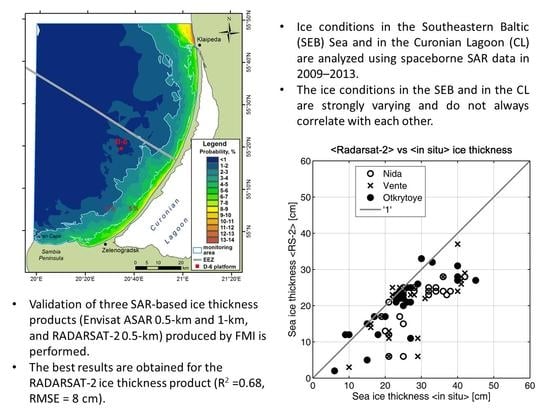Remote Sensing of Ice Conditions in the Southeastern Baltic Sea and in the Curonian Lagoon and Validation of SAR-Based Ice Thickness Products
Abstract
1. Introduction
2. Study Area
3. Materials and Methods
4. Results
4.1. Ice Conditions in 2009–2013
4.2. Validation of SAR-Based Ice Thickness Products
5. Discussion
6. Conclusions
Author Contributions
Funding
Acknowledgments
Conflicts of Interest
References
- Granskog, M.; Kaartokallio, H.; Kuosa, H.; Thomas, D.N.; Vainio, J. Sea ice in the Baltic Sea—A review. Estuar. Coast. Shelf Sci. 2006, 70, 145–160. [Google Scholar] [CrossRef]
- Chubarenko, B.; Chechko, V.; Kileso, A.; Krek, E.; Topchaya, V. Hydrological and sedimentation conditions in a non-tidal lagoon during ice coverage—The example of Vistula Lagoon in the Baltic Sea. Estuar. Coast. Shelf Sci. 2019, 216, 38–53. [Google Scholar] [CrossRef]
- Idzelytė, R.; Kozlov, I.E.; Umgiesser, G. Remote sensing of ice phenology and dynamics of Europe’s largest coastal lagoon (The Curonian Lagoon). Remote Sens. 2019, 11, 2059. [Google Scholar] [CrossRef]
- Eremina, T.R.; Bugrov, L.Y.; Maksimov, A.A.; Ryabchenko, V.A.; Shilin, M.B. The Baltic Sea. In Second Assessment Report of Roshydromet on Climate Change and Its Concequences on Territory of Russian Federation; Kattsov, V.M., Semenov, S.M., Eds.; Institute of Global Climate and Ecology: Moscow, Russia, 2014; pp. 615–643. (In Russian) [Google Scholar]
- Dailidienė, I.; Baudler, H.; Chubarenko, B.; Navrotskaya, S. Long term water level and surface temperature changes in the lagoons of the southern and eastern Baltic. Oceanologia 2011, 53, 293–308. [Google Scholar] [CrossRef]
- Omstedt, A.; Elken, J.; Lehmann, A.; Leppäranta, M.; Meier, H.E.M.; Myrberg, K.; Rutgersson, A. Progress in physical oceanography of the Baltic Sea during the 2003–2014 period. Prog. Oceanogr. 2014, 128, 139–171. [Google Scholar] [CrossRef]
- Serykh, I.V.; Kostianoy, A.G. About the climatic changes in the temperature of the Baltic Sea. Fundam. Prikl. Gidrofiz. 2019, 12, 5–12. [Google Scholar]
- Helsinki Commission (HELCOM). Climate Change in the Baltic Sea Area: HELCOM Thematic Assessment in 2013; Baltic Sea Environment Proceedings No. 137; Helsinki Commission: Helsinki, Finland, 2013; 66p. [Google Scholar]
- Elken, J.; Lehmann, A.; Myrberg, K. Recent changes in Baltic Sea oceanographic conditions, with some effects to the ecosystem status. In Proceedings of the 10th Baltic Sea Science Congress, Riga, Latvia, 15–19 June 2015; p. 34. [Google Scholar]
- Haapala, J.; Ronkainen, L.; Schmelzer, N.; Sztobryn, M. Recent change—Sea ice. In Second Assessment of Climate Change for the Baltic Sea Basin; The BACC Author Team, Ed.; Springer: Cham, Switzerland, 2008; pp. 145–153. [Google Scholar]
- Von Storch, H.; Barkhordarian, A. Detection and attribution of climate change in the Baltic Sea Region. In Proceedings of the 10th Baltic Sea Science Congress, Riga, Latvia, 15–19 June 2015; p. 8. [Google Scholar]
- Dailidienė, I.; Davulienė, L.; Kelpšaitė, L.; Razinkovas, A. Analysis of the climate change in Lithuanian coastal areas of the Baltic Sea. J. Coast. Res. 2012, 28, 557–569. [Google Scholar] [CrossRef]
- Kļaviņš, M.; Avotniece, Z.; Rodinovs, V. Dynamics and impacting factors of ice regimes in Latvia inland and coastal waters. Proc. Latv. Acad. Sci. 2016, 70, 400–408. [Google Scholar] [CrossRef]
- Krek, E.V.; Stont, Z.I.; Bukanova, T.V. Ice conditions in the Southeastern Baltic Sea from satellite data (2004–2019). J. Ocean Res. 2020, 48, 18–33. (In Russian) [Google Scholar] [CrossRef]
- Dailidienė, I. Kuršių marių hidrologinio režimo pokyčiai. Geografija 2007, 43, 36–43. [Google Scholar]
- Bagdanavičiūtė, I.; Umgiesser, G.; Vaičiūtė, D.; Bresciani, M.; Kozlov, I.; Zaiko, A. GIS-based multi-criteria site selection for zebra mussel cultivation: Addressing end-of-pipe remediation of a eutrophic coastal lagoon ecosystem. Sci. Total Environ. 2018, 634, 990–1003. [Google Scholar] [CrossRef] [PubMed]
- Karvonen, J.; Simila, M.; Heiler, I. Ice thickness estimation using SAR data and ice thickness history. In Proceedings of the IEEE International Geoscience and Remote Sensing Symposium 2003 (IGARSS 03), Toulouse, France, 21–25 July 2003; Volume 1, pp. 74–76. [Google Scholar]
- Similä, M.; Karvonen, J.; Haas, C. Inferring the degree of ice field deformation in the Baltic Sea using Envisat ASAR images. In Advances in SAR Oceanography from Envisat and ERS Missions, Proceedings of the SEASAR 2006, Frascati, Italy, 23–26 January 2006; Lacoste, H., Ouwehand, L., Eds.; ESA Publications Division, ESTEC: Noordwijk, The Netherlands, 2006. [Google Scholar]
- Askne, J.; Dierking, W. Sea ice monitoring in the Arctic and Baltic Sea using SAR. In Remote Sensing of the European Seas; Barale, V., Gade, M., Eds.; Springer: Dordrecht, The Netherlands, 2008; pp. 383–398. [Google Scholar] [CrossRef]
- Karvonen, J. Operational SAR-based sea ice drift monitoring over the Baltic Sea. Ocean Sci. 2012, 8, 473–483. [Google Scholar] [CrossRef]
- Karvonen, J. Evaluation of the operational SAR based Baltic Sea ice concentration products. Adv. Space Res. 2015, 56, 119–132. [Google Scholar] [CrossRef]
- Eastwood, S.; Karvonen, J.; Dinessen, F.; Fleming, A.; Pedersen, L.T.; Saldo, R.; Buus-Hinkler, J.; Hackett, B.; Ardhuin, F.; Kreiner, M.B.; et al. Quality Information Document for SI TAC Sea Ice Products; EU Copernicus Marine Service, 2020; Issue 2.9; 71p, Available online: https://cmems-resources.cls.fr/documents/QUID/CMEMS-OSI-QUID-011-001to007-009to012.pdf (accessed on 6 October 2020).
- Žaromskis, R. Oceans, Seas, Estuaries; Debesija: Vilnius, Lithuania, 1996. (In Lithuanian) [Google Scholar]
- Gasiūnaitė, Z.R.; Daunys, D.; Olenin, S.; Razinkovas, A. The Curonian Lagoon. In Ecology of Baltic Coastal Waters; Schiewer, U., Ed.; Springer: Berlin/Heidelberg, Germany, 2008; pp. 197–215. [Google Scholar] [CrossRef]
- Dailidienė, I.; Davulienė, L. Salinity trend and variation in the Baltic Sea near the Lithuanian coast and in the Curonian Lagoon in 1984–2005. J. Mar. Syst. 2008, 74, 20–29. [Google Scholar] [CrossRef]
- Onstott, R.G.; Shuchman, R.A. SAR measurements of sea ice. In Synthetic Aperture Radar Marine User’s Manual; Jackson, C.R., Apel, J.R., Eds.; U.S. Department of Commerce: Washington, DC, USA, 2004; pp. 81–115. [Google Scholar]
- Johannessen, O.M.; Alexandrov, V.Y.; Frolov, I.Y.; Bobylev, L.P.; Sandven, S.; Pettersson, L.H.; Kloster, K.; Babich, N.G.; Mironov, Y.U.; Smirnov, V.G. Remote Sensing of Sea Ice in the Northern Sea Route: Studies and Applications; Springer: Chichester, UK, 2007. [Google Scholar]
- Dierking, W. Sea ice monitoring by synthetic aperture radar. Oceanography 2013, 26, 100–111. [Google Scholar] [CrossRef]
- Muckenhuber, S.; Nilsen, F.; Korosov, A.; Sandven, S. Sea ice cover in Isfjorden and Hornsund, Svalbard (2000–2014) from remote sensing data. Cryosphere 2016, 10, 149–158. [Google Scholar] [CrossRef]
- Kozlov, I.; Dailidienė, I.; Korosov, A.; Klemas, V.; Mingėlaitė, T. MODIS-based sea surface temperature of the Baltic Sea Curonian Lagoon. J. Mar. Syst. 2014, 129, 157–165. [Google Scholar] [CrossRef]
- Dabuleviciene, T.; Kozlov, I.E.; Vaiciute, D.; Dailidiene, I. Remote sensing of coastal upwelling in the South-Eastern Baltic Sea: Statistical properties and implications for the coastal environment. Remote Sens. 2018, 10, 1752. [Google Scholar] [CrossRef]
- Karimova, S.S.; Gade, M. Improved statistics of sub-mesoscale eddies in the Baltic Sea retrieved from SAR imagery. Int. J. Rem. Sens. 2016, 37, 2394–2414. [Google Scholar] [CrossRef]
- Ginzburg, A.I.; Krek, E.V.; Kostianoy, A.G.; Solovyev, D.M. Evolution of mesoscale anticyclonic vortex and vortex dipoles/multipoles on its base in the South-Eastern Baltic (satellite information: May–July 2015). J. Ocean Res. 2017, 45, 10–22. (In Russian) [Google Scholar] [CrossRef][Green Version]
- Ginzburg, A.I.; Krek, E.V.; Kostianoy, A.G.; Solovyev, D.M. On the role of mesoscale vortices in the oil spill transport in the Southeastern Baltic Sea (satellite information). J. Ocean Res. 2019, 47, 8–19. (In Russian) [Google Scholar] [CrossRef]
- Kozlov, I.E.; Kudryavtsev, V.N.; Johannessen, J.A.; Chapron, B.; Dailidienė, I.; Myasoedov, A.G. ASAR imaging for coastal upwelling in the Baltic Sea. Adv. Space Res. 2012, 50, 1125–1137. [Google Scholar] [CrossRef]
- Kozlov, I.E.; Artamonova, A.V.; Manucharyan, G.E.; Kubryakov, A.A. Eddies in the Western Arctic Ocean from spaceborne SAR observations over open ocean and marginal ice zones. J. Geophys. Res. Oceans 2019, 124, 6601–6616. [Google Scholar] [CrossRef]
- Kozlov, I.E.; Plotnikov, E.V.; Manucharyan, G.E. Brief Communication: Mesoscale and submesoscale dynamics of marginal ice zone from sequential SAR observations. Cryosphere 2020, 14, 2941–2947. [Google Scholar] [CrossRef]
- Stont, Z.; Bulycheva, E.; Bukanova, T. Ice conditions in the South-Eastern Baltic by satellite data and field observations in 2006–2013. In Proceedings of the Baltic Sea Science Congress, Klaipėda, Lithuania, 26–30 August 2013; p. 251. [Google Scholar]
- Karvonen, J.; Heiler, I.; Seinä, A.; Hackett, B. Product User Manual for Baltic Sea Ice Products SEAICE_BAL_SEAICE_L4_NRT_OBSERVATIONS_011_004/011; EU Copernicus Marine Service, 2018; Issue 2.7; 28p, Available online: https://resources.marine.copernicus.eu/documents/PUM/CMEMS-OSI-PUM-010-016.pdf (accessed on 6 October 2020).
- Zemlys, P.; Ferrarin, C.; Umgiesser, G.; Gulbinskas, S.; Bellafiore, D. Investigation of saline water intrusions into the Curonian Lagoon (Lithuania) and two-layer flow in the Klaipėda Strait using finite element hydrodynamic model. Ocean Sci. 2013, 9, 573–584. [Google Scholar] [CrossRef]
- Löptien, U.; Axell, L. Ice and AIS: Ship speed data and sea ice forecasts in the Baltic Sea. Cryosphere 2014, 8, 2409–2418. [Google Scholar] [CrossRef]
- Idzelytė, R.; Mėžinė, J.; Zemlys, P.; Umgiesser, G. Study of ice cover impact on hydrodynamic processes in the Curonian Lagoon through numerical modeling. Oceanologia 2020. [Google Scholar] [CrossRef]
- Similä, M.; Mäkynen, M.; Cheng, B.; Rinne, E. Multisensor data and thermodynamic sea-ice model based sea-ice thickness chart with application to the Kara Sea, Arctic Russia. Ann. Glaciol. 2013, 54, 241–252. [Google Scholar] [CrossRef]
- Melsheimer, C.; Mäkynen, M.; Rasmussen, T.; Rudjord, Ø.; Simila, M.; Sohlberg, R.; Walker, N. Comparison and validation of four Arctic sea ice thickness products of the EC POLAR ICE project. In Proceedings of the ESA Living Planet Symposium 2016, Prague, Czech Republic, 9–13 May 2016; Volume 740, p. 8. [Google Scholar]
- Karvonen, J.; Rinne, E.; Sallila, H.; Mäkynen, M. On suitability of ALOS-2/PALSAR-2 dual-polarized SAR data for Arctic sea ice parameter estimation. IEEE Trans. Geosci. Rem. Sens. 2020, 58, 7969–7981. [Google Scholar] [CrossRef]
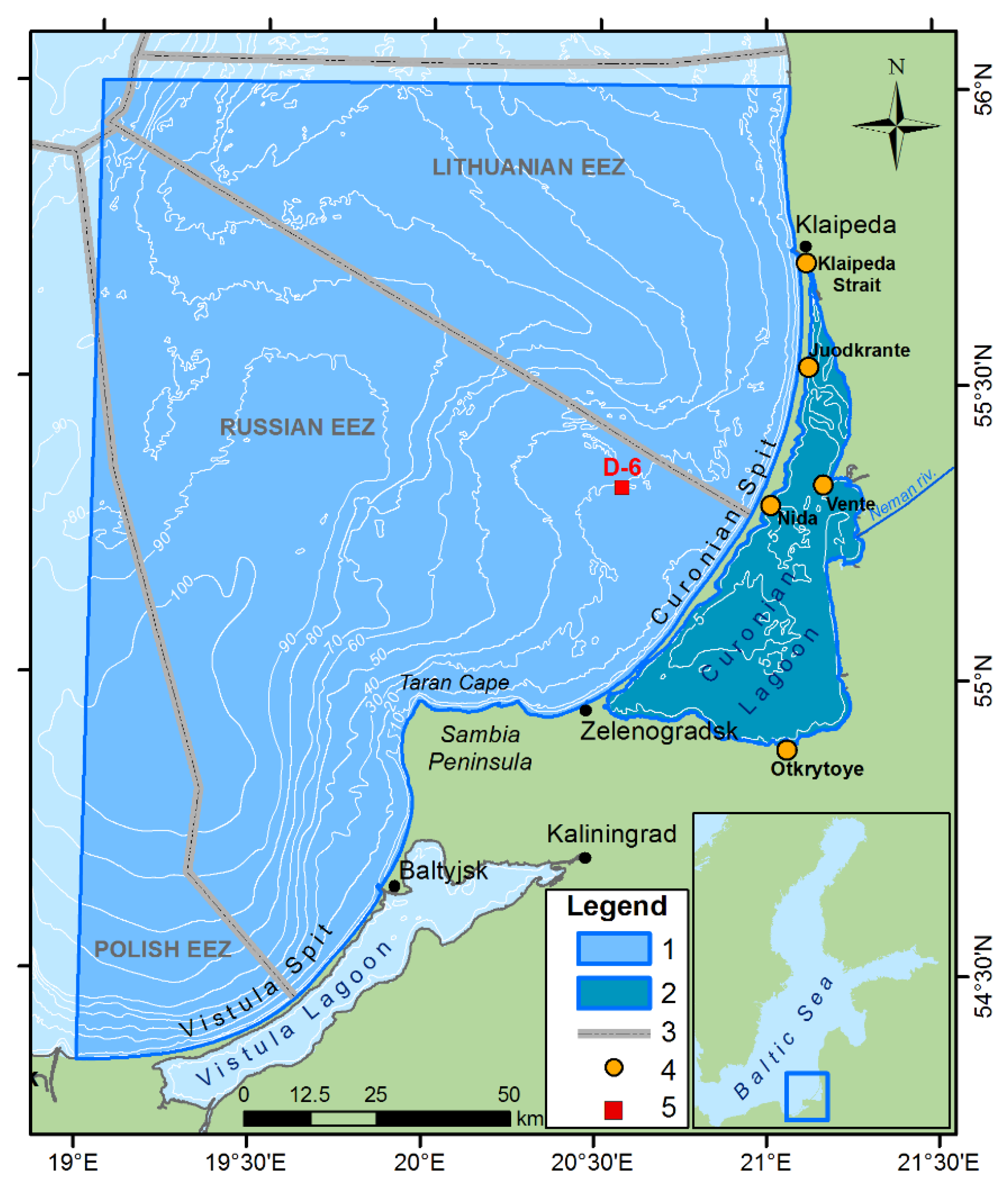
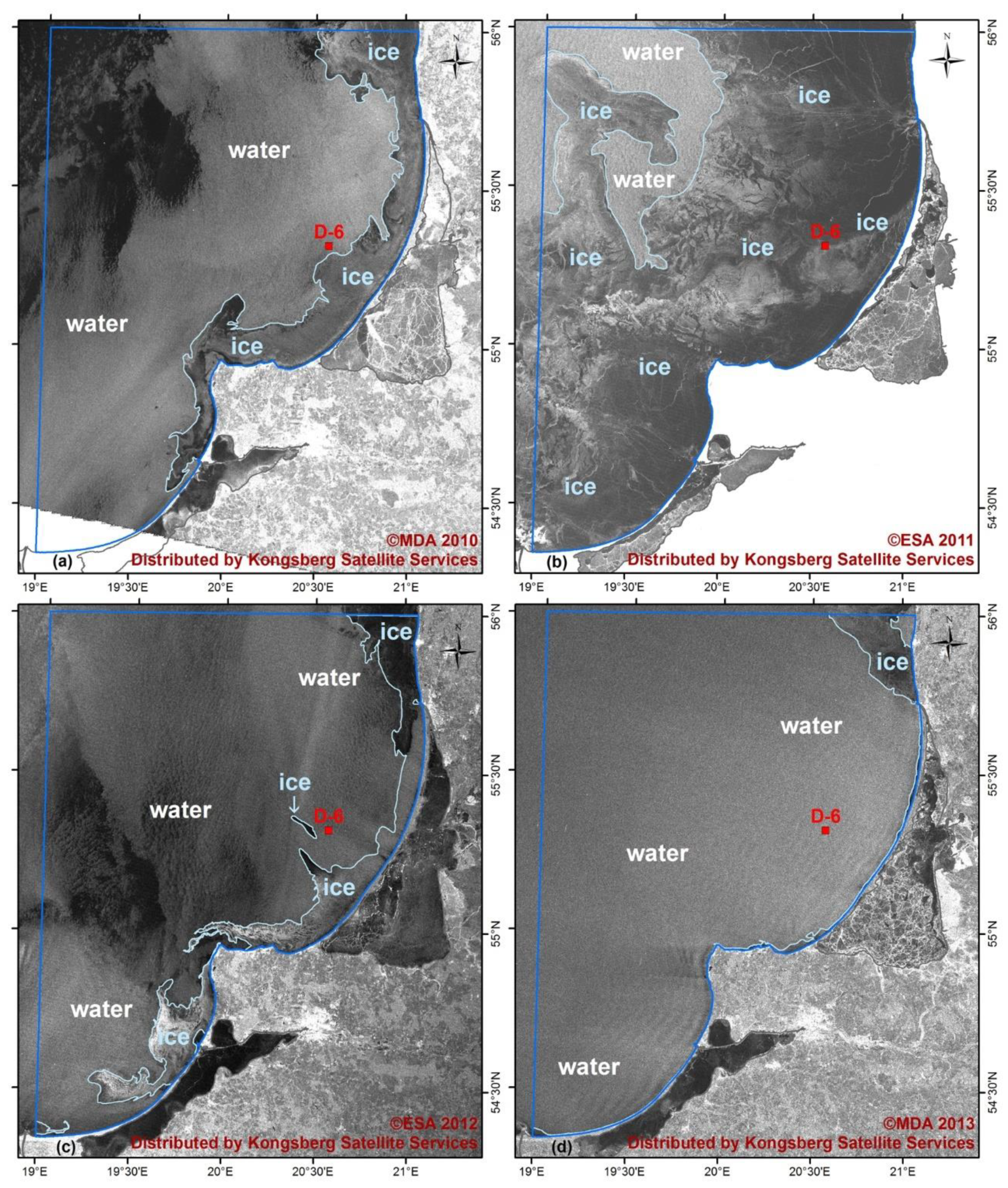

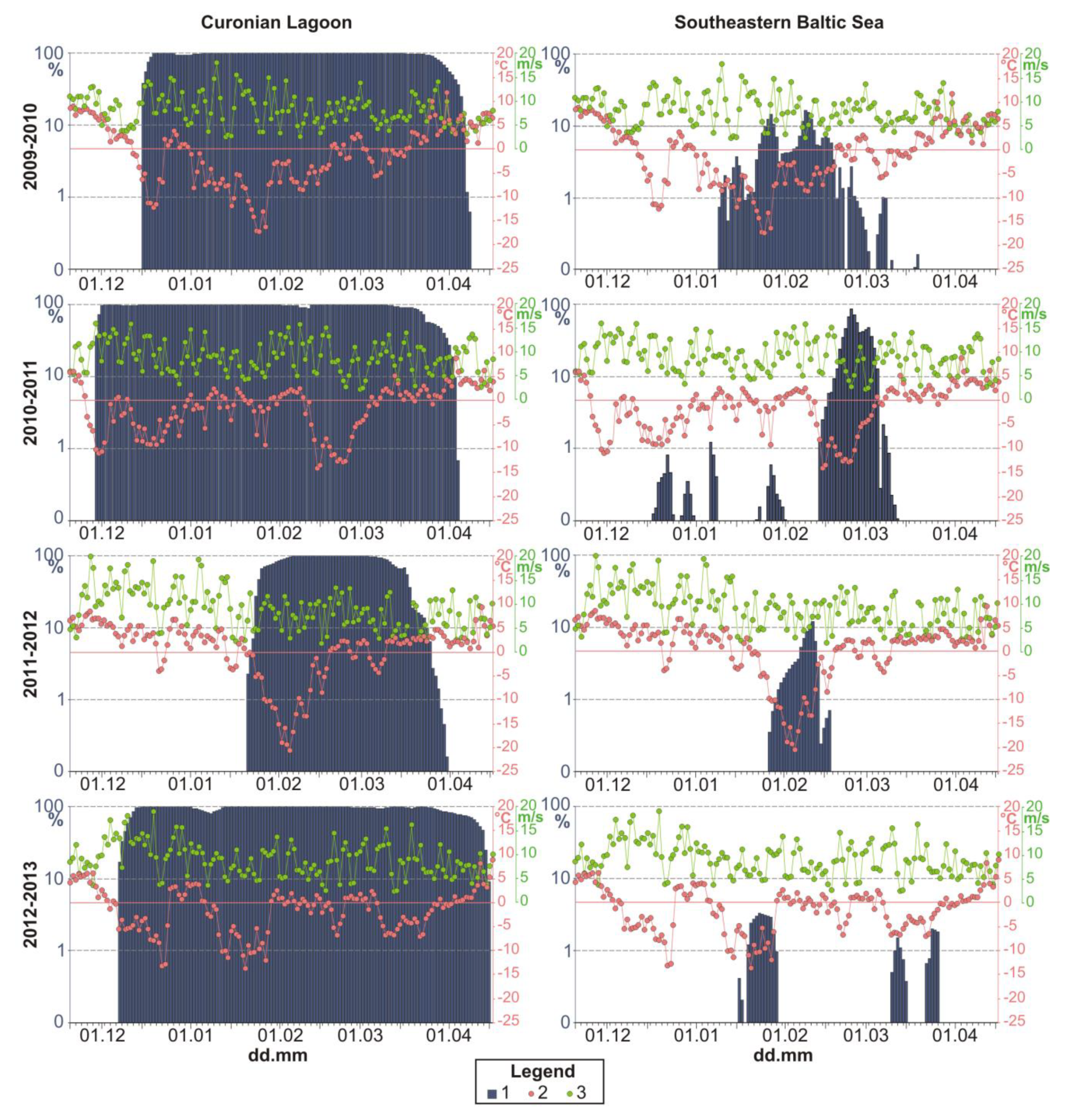
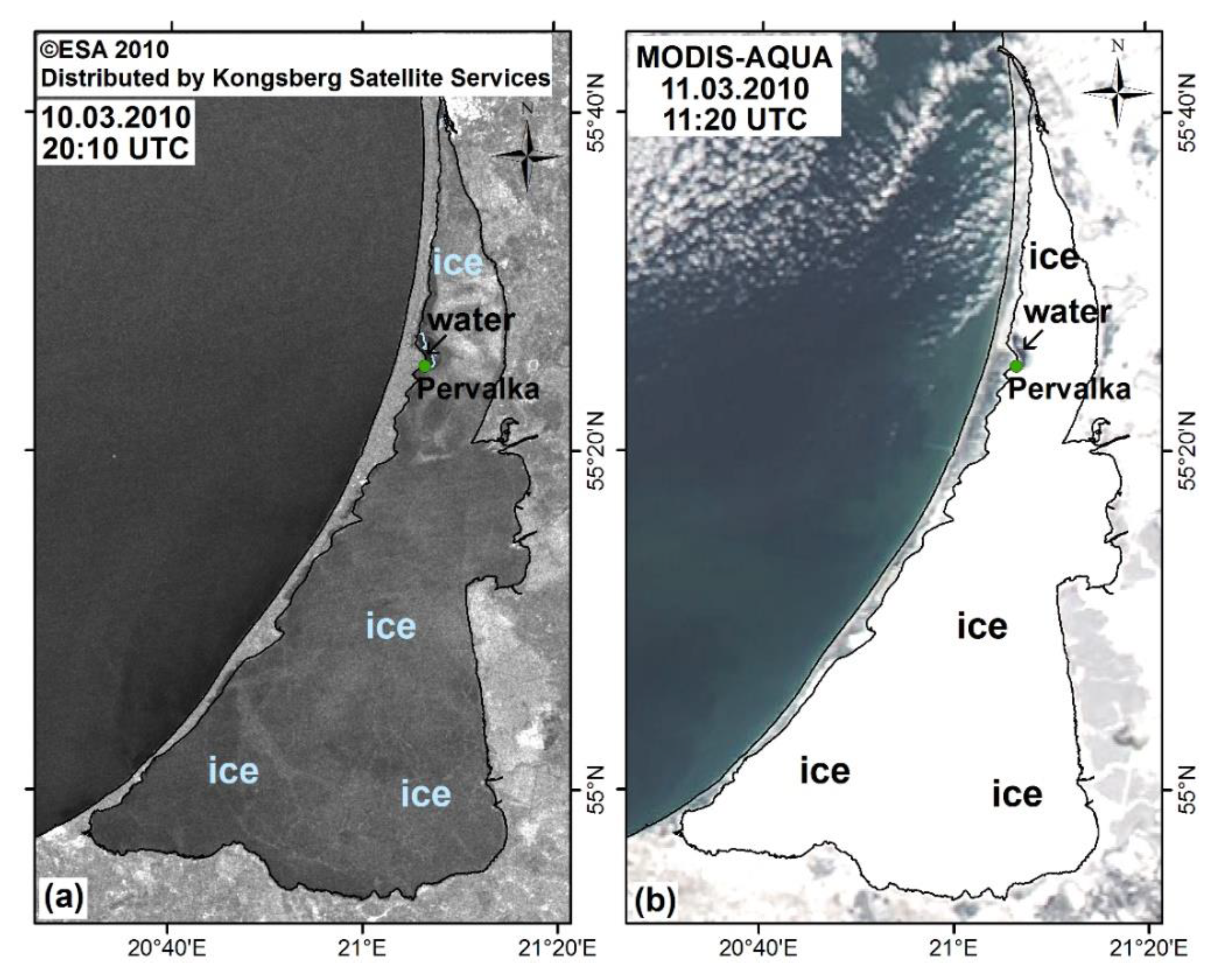
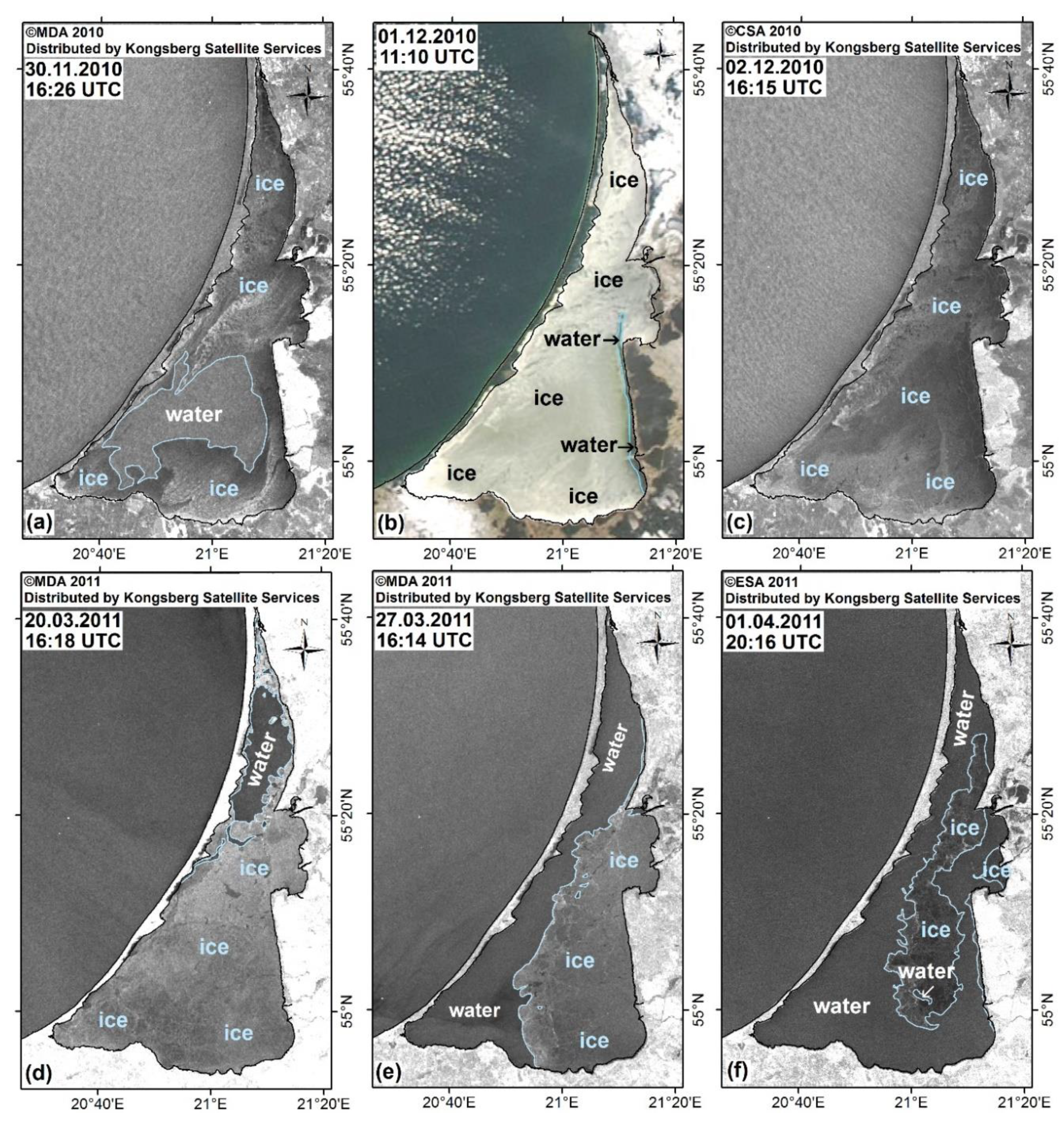
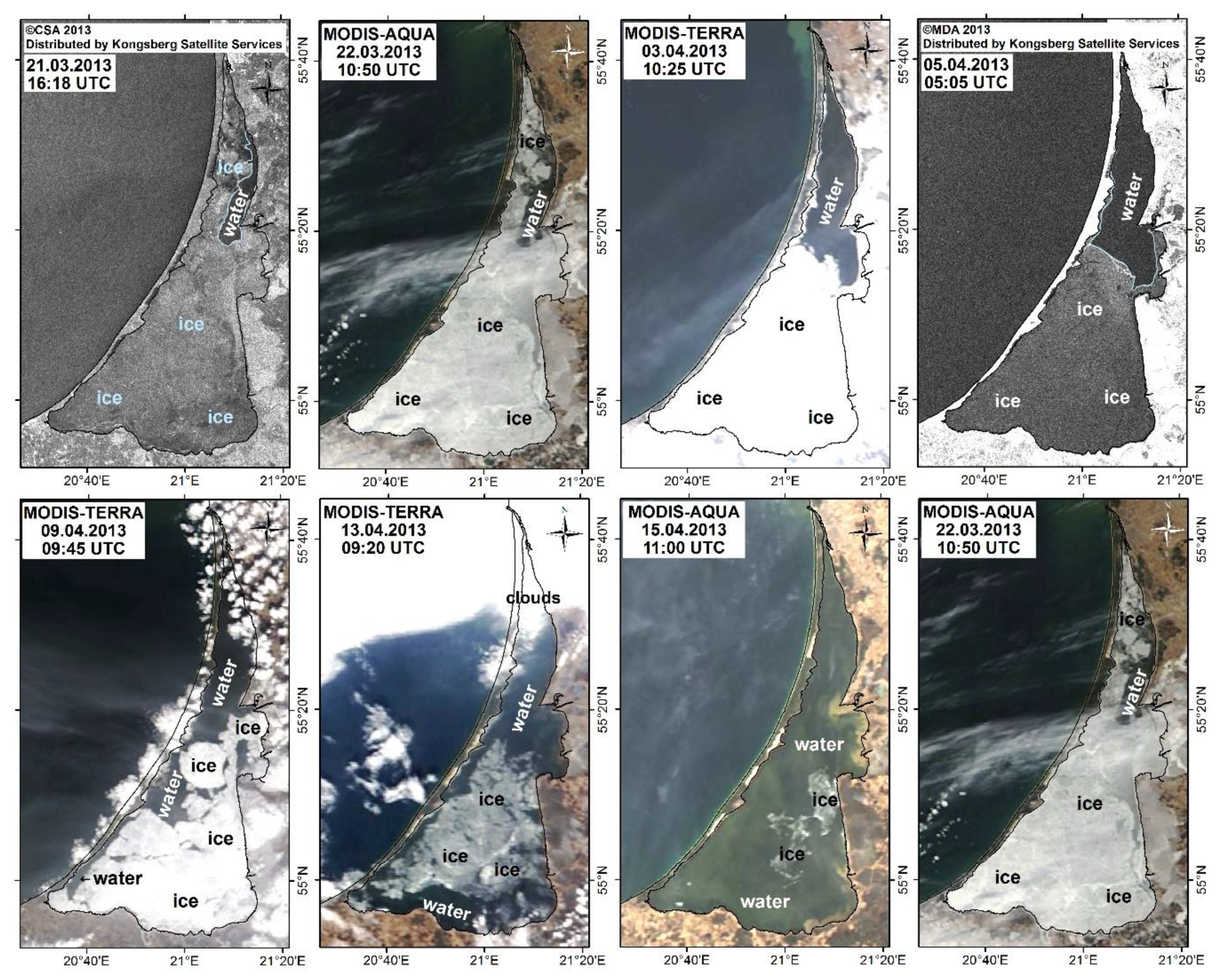
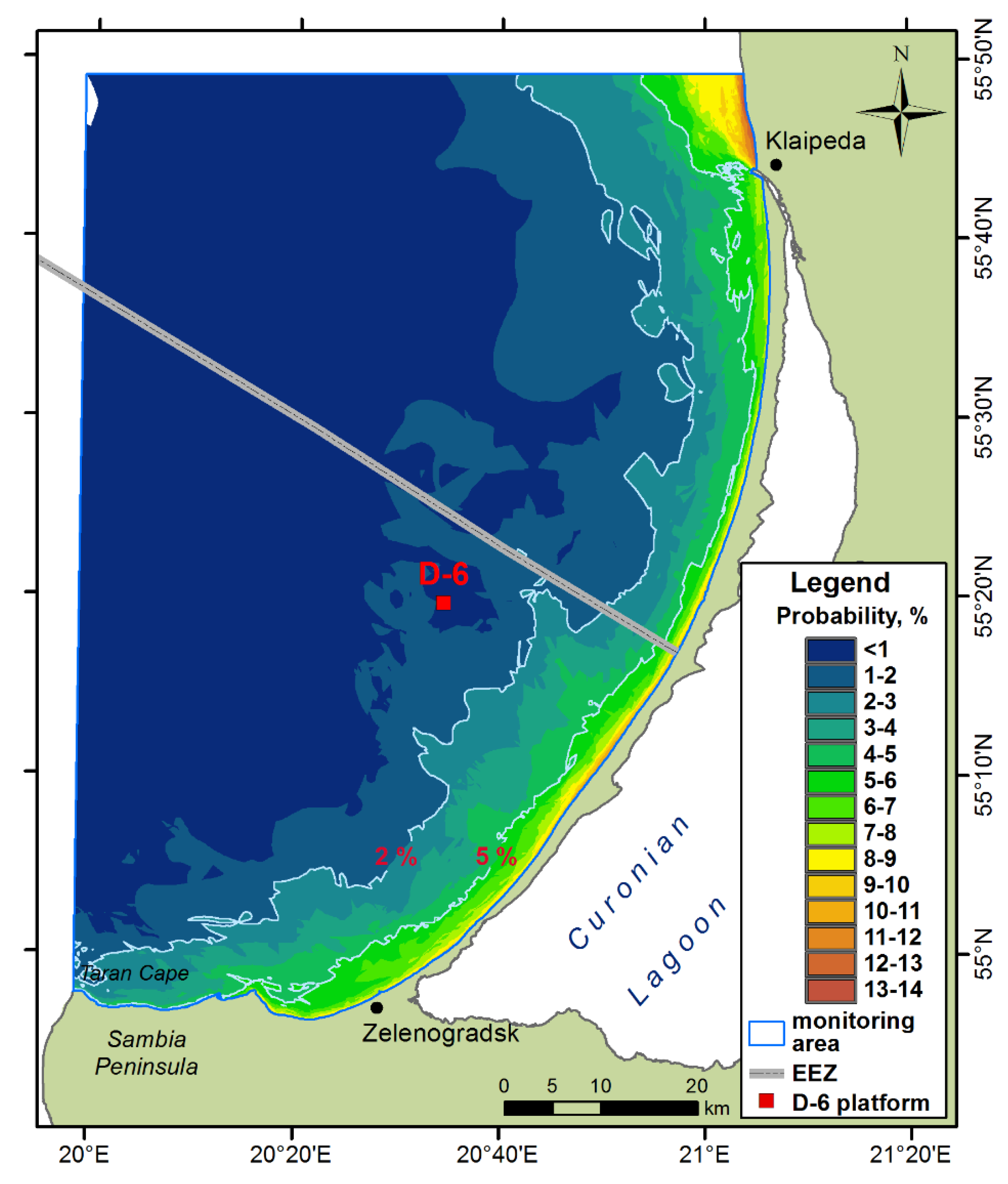
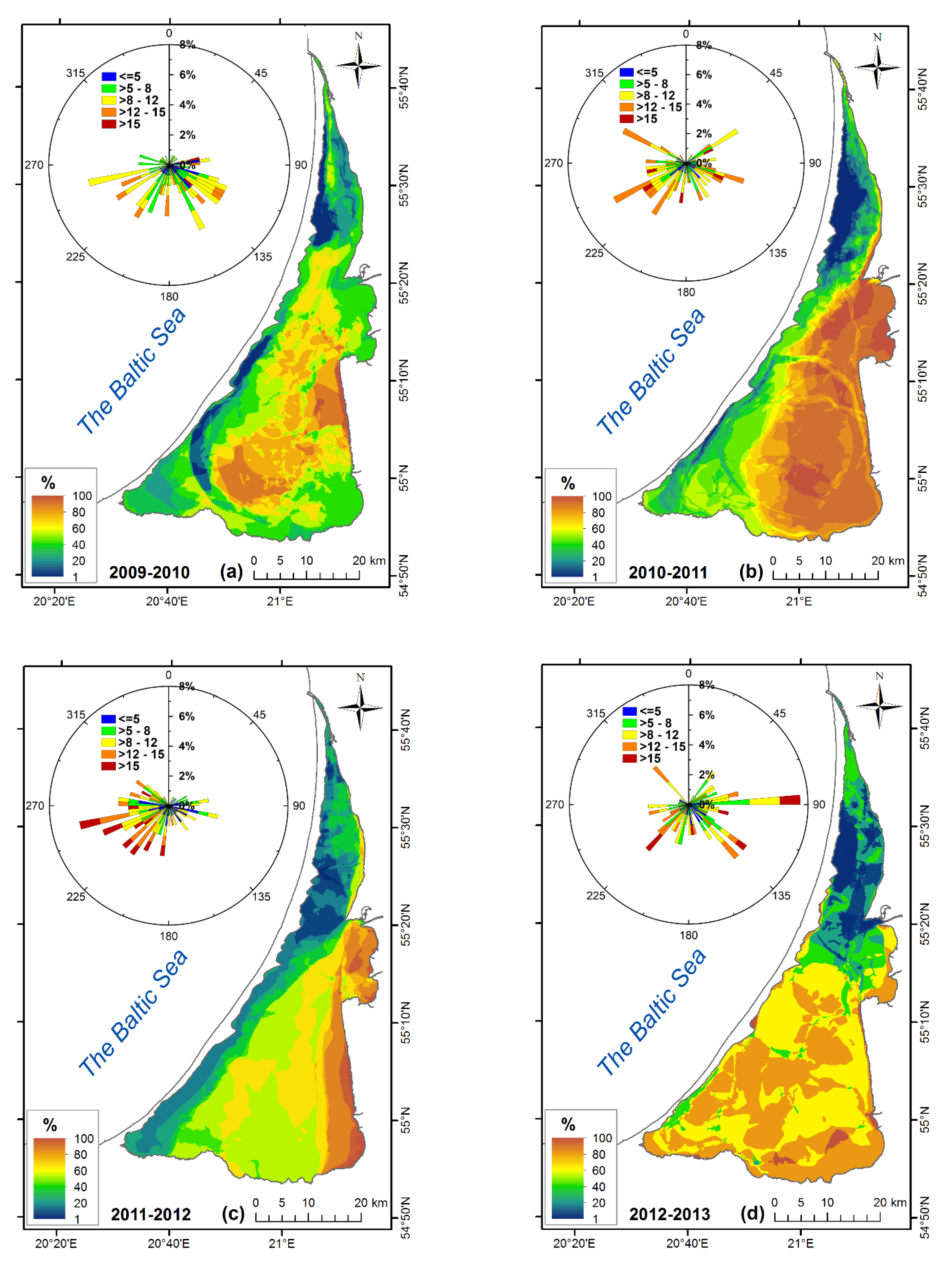
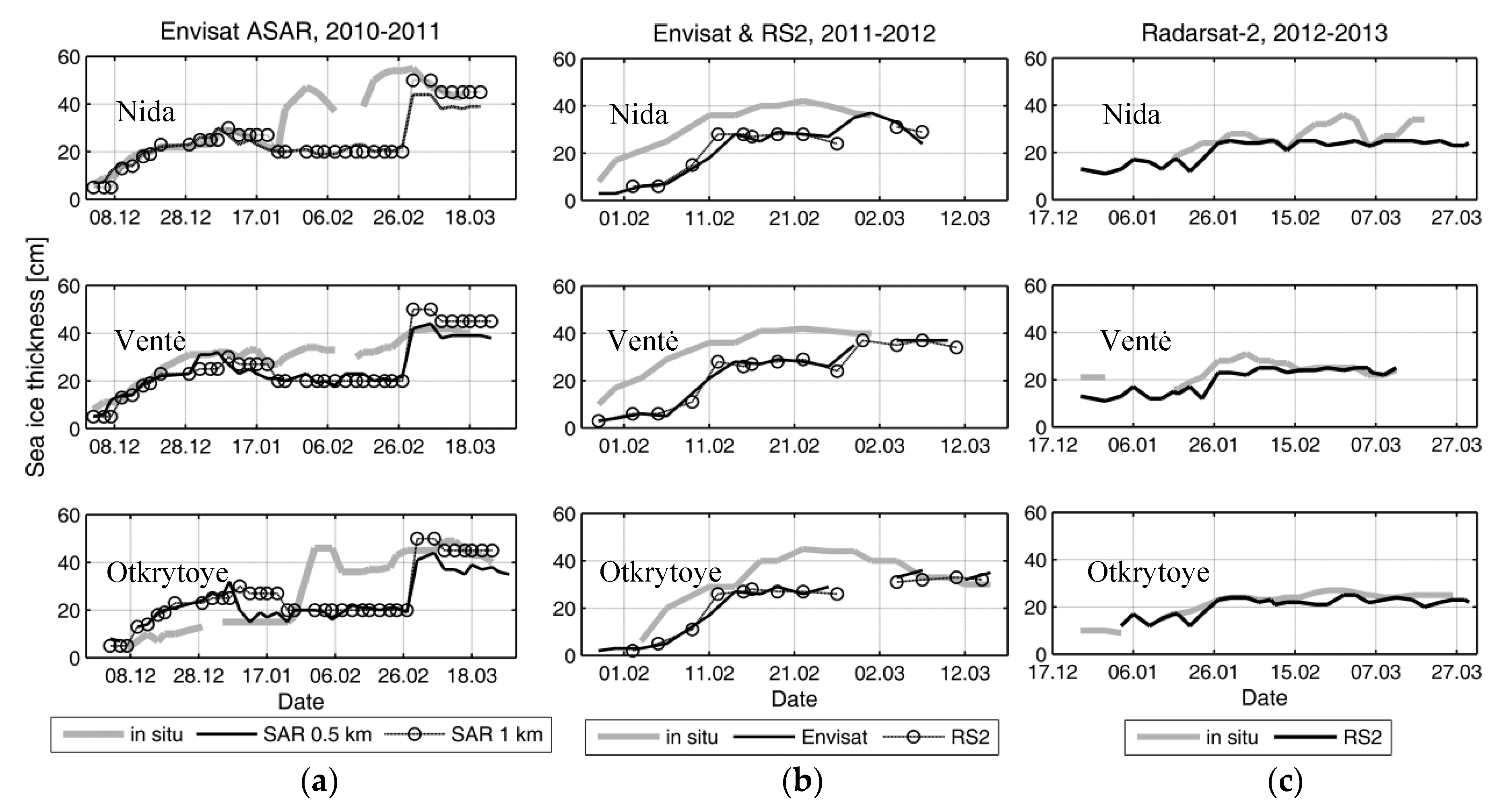

| Satellite | Band | Scene Size, km | Spatial Resolution, m | Number of Images | Period |
|---|---|---|---|---|---|
| Envisat ASAR | C | 400 × 400 | 150 × 150 | 144 | November 2009–April 2012 |
| RADARSAT-1 | C | 300 × 300 | 50 × 50 | 63 | December 2009–March 2013 |
| RADARSAT-2 | C | 500 × 500 | 100 × 100 | 70 | December 2009–April 2013 |
| Station | ASAR 1-km | ASAR 0.5-km | RS-2 0.5-km | ||||||
|---|---|---|---|---|---|---|---|---|---|
| N | R | RMSE, cm | N | R | RMSE, cm | N | R | RMSE, cm | |
| Nida | 37 | 0.55 | 14.9 | 46 | 0.61 | 14.1 | 35 | 0.58 | 8.8 |
| Ventė | 39 | 0.81 | 8.6 | 46 | 0.81 | 9.7 | 33 | 0.65 | 9 |
| Otkrytoye | 40 | 0.57 | 13.5 | 47 | 0.59 | 13 | 41 | 0.78 | 6.7 |
| All | 116 | 0.59 | 12.6 | 139 | 0.64 | 12.4 | 109 | 0.68 | 8.1 |
Publisher’s Note: MDPI stays neutral with regard to jurisdictional claims in published maps and institutional affiliations. |
© 2020 by the authors. Licensee MDPI, Basel, Switzerland. This article is an open access article distributed under the terms and conditions of the Creative Commons Attribution (CC BY) license (http://creativecommons.org/licenses/by/4.0/).
Share and Cite
Kozlov, I.E.; Krek, E.V.; Kostianoy, A.G.; Dailidienė, I. Remote Sensing of Ice Conditions in the Southeastern Baltic Sea and in the Curonian Lagoon and Validation of SAR-Based Ice Thickness Products. Remote Sens. 2020, 12, 3754. https://doi.org/10.3390/rs12223754
Kozlov IE, Krek EV, Kostianoy AG, Dailidienė I. Remote Sensing of Ice Conditions in the Southeastern Baltic Sea and in the Curonian Lagoon and Validation of SAR-Based Ice Thickness Products. Remote Sensing. 2020; 12(22):3754. https://doi.org/10.3390/rs12223754
Chicago/Turabian StyleKozlov, Igor E., Elena V. Krek, Andrey G. Kostianoy, and Inga Dailidienė. 2020. "Remote Sensing of Ice Conditions in the Southeastern Baltic Sea and in the Curonian Lagoon and Validation of SAR-Based Ice Thickness Products" Remote Sensing 12, no. 22: 3754. https://doi.org/10.3390/rs12223754
APA StyleKozlov, I. E., Krek, E. V., Kostianoy, A. G., & Dailidienė, I. (2020). Remote Sensing of Ice Conditions in the Southeastern Baltic Sea and in the Curonian Lagoon and Validation of SAR-Based Ice Thickness Products. Remote Sensing, 12(22), 3754. https://doi.org/10.3390/rs12223754




